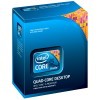- Qualcomm Launches Snapdragon 4 Gen 2 Mobile Platform
- AMD Launches Ryzen PRO 7000 Series Mobile & Desktop Platform
- Intel Launches Sleek Single-Slot Arc Pro A60 Workstation Graphics Card
- NVIDIA Announces Latest Ada Lovelace Additions: GeForce RTX 4060 Ti & RTX 4060
- Maxon Redshift With AMD Radeon GPU Rendering Support Now Available
Intel Core i7-870 & i5-750 – Nehalem for the Mainstream

The wait for Intel’s Lynnfield has been long, but it’s safe to say that it’s been well worth it. They may be considered “mainstream” models, but the new Core i5 and i7 processors are powerful. Expect faster performance, improved power consumption and greater efficiency. With the i5-750 set to sell for $199, the time to build that new PC is now.
Page 9 – System: Sandra Memory, Multi-Core Efficiency
Generally speaking, the faster the processor, the higher the system-wide bandwidth and the lower the latency. As is always the case, faster is better when it comes to processors, as we’ll see below. But with Core i7, the game changes up a bit.
Whereas previous memory controllers utilized a dual-channel operation, Intel threw that out the window to introduce triple-channel, which we talked a lot about at August’s IDF. Further, since Intel integrates the IMC onto the die of the new CPUs, benefits are going to be seen all-around.
Before jumping into the results, we already had an idea of what to expect, and just as we did, the results seen are nothing short of staggering.

It’s no triple-channel memory controller, but the bandwidth it still huge. Not that the comparison between the Lynnfield results and AMD’s isn’t too fair, as each machine was running memory at different settings. Chances are anything above 10,000 MB/s is going to be overkill for most people. That’s not really a bad thing. It’s better than having the opposite occur.

For both the Cache and Latency, the Turbo feature really, really helps push the Lynnfields ahead. There’s just no comparison here. The only thing that really comes close in the latency test are Dual-Core CPUs, and the Cache bandwidth is almost uncomparable – except to Nehalem.
Sandra 2009 Multi-Core Efficiency
How fast can one core swap data with another? It might not seem that important, but it definitely is if you are dealing with a true multi-threaded application. The faster data can be swapped around, the faster it’s going to be finished, so overall, inter-core speeds are important in every regard.
Even without looking at the data, we know that Core i7 is going to excel here, for a few different reasons. The main is the fact that this is Intel’s first native Quad-Core. Rather than have two Dual-Core dies placed beside each other, i7 was built to place four cores together, so that in itself improves things. Past that, the ultra-fast QPI bus likely also has something to do with speed increases.

This test is interesting, because I would have expected to see the i5-750 hit a higher spot than this. Instead, it was beat out by previous Core 2 Quad-Cores. Of course, HyperThreading is making its mark again, which is why the top CPUs in the chart include the support.
Support our efforts! With ad revenue at an all-time low for written websites, we're relying more than ever on reader support to help us continue putting so much effort into this type of content. You can support us by becoming a Patron, or by using our Amazon shopping affiliate links listed through our articles. Thanks for your support!





